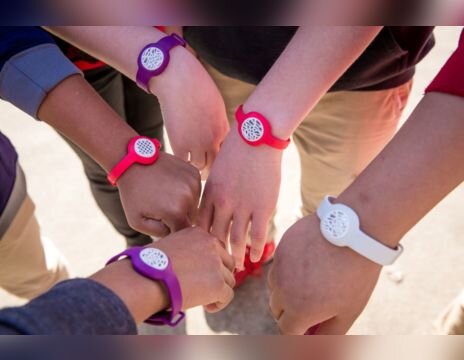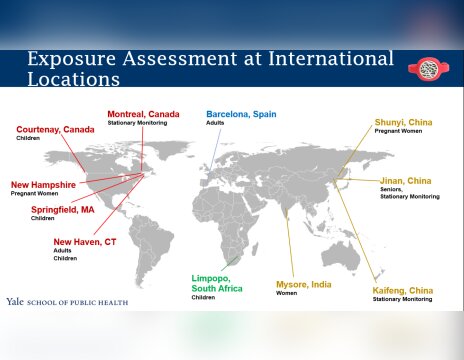TECH

Wristband monitors personal exposure to air pollution
Whether it comes from second-hand cigarette smoke, motor vehicle exhaust, building materials or the fumes from household cleaning supplies, toxic air is all around us.
Doctors and scientists are notably concerned about air pollution as it ranks among the top 10 global health risks associated with non-communicable diseases. Organic air pollutants have been shown to contribute to respiratory and cardiac disease as well as reproductive and neurobehavioral problems.
Yet measuring personal exposure levels remains tricky.
Some scientists use expensive air monitors placed in strategic locations. Others employ bulky backpacks loaded with expensive filters and pumps. Wearable detection badges are useful for people working dangerous jobs. Yet each approach has its own limitations, from time consuming laboratory analysis to high risks of unrelated environmental contamination.
Yale School of Public Health Assistant Professor Krystal Pollitt is introducing a new option–a lightweight, unobtrusive, wearable air pollutant sampler she calls the Fresh Air wristband.
During initial testing, the device reliably collected and retained air pollutant molecules over time, allowing for easy analysis and scale-up to monitor large segments of a population.
While the wristband was initially designed to detect air pollutants, in light of the current pandemic, Pollitt is exploring its potential use in monitoring exposure to small airborne pathogens such as coronavirus. She is working with Jordan Peccia, the Thomas E. Golden Jr. professor of chemical and environmental engineering, and Dr. Jodi Sherman, associate professor of anesthesiology and of epidemiology (environmental health sciences), in conducting a field test of the wristbands' capabilities with the help of health care providers at Yale New Haven Hospital.
In a study recently published in the journal Environmental Science & Technology Letters, Pollitt and a team of YSPH graduate students used the Fresh Air wristband to investigate air pollutant exposure in a group of school-aged children in Springfield, Massachusetts. In this first large scale test of the device, the wristbands detected elevated levels of exposure to pyrene, nitrogen dioxide and other pollutants among children with asthma, those living in certain housing conditions and those taking cars rather than buses to school, illustrating the wristband's potential applications.

"These results show the potential utility of the Fresh Air wristband as a wearable personal air pollutant sampler capable of assessing exposure among vulnerable populations, especially young children and pregnant women," said Pollitt, who holds joint appointments in the YSPH Department of Environmental Health Sciences and the Department of Chemical and Environmental Engineering in the Yale School of Engineering & Applied Science.
So how does it work? The Fresh Air wristband looks like a fashionable Swatch wristwatch with a quarter-sized plastic air sampler embedded where the watch face would normally be. Pop open the cover and inside is a small foam pad coated with a chemical (triethanolamine) that reacts with nitrogen dioxide, an air pollutant that is a byproduct of burned fossil fuels such as coal, oil and natural gas. The device also contains a small sorbent bar made of a silicone-based polymer (polydimethylsiloxane). The bar collects volatile organic compounds (the chemicals found in such things as glue, pesticides, cigarettes, and solvents) and polycyclic aromatic hydrocarbons (PAHs) like phenanthrene and chrysene, which can be found in car exhaust, cigarette smoke, wood smoke and fumes from cooking. The Fresh Air wristband is particularly good at capturing heavier molecular compounds and retaining them over multiple days.
The sampling pad and sorbent bars contained in the wristband can be easily inserted and removed, especially when testing personal exposures over time. As samples are collected, the wristband materials are placed in airtight amber glass vials for preservation until chemical analysis. Rather than extracting the samples using solvents (a labor-intensive lab process), Pollitt says her device allows for faster and easier analysis using mass spectrometry to get a detailed chemical profile of a person's chemical exposures.
In the Springfield study, 33 children ages 12 and13 wore the wristbands for 5 days, only taking them off at night where they were left next to their beds. The participants were predominately girls (69%) and a third had physician-diagnosed asthma. Key findings included:
-Girls had higher levels of pollutant exposure than boys.
-Children with asthma had elevated exposures to pyrene and acenapthylene, two aromatic hydrocarbons which could exacerbate breathing problems.
-Children living in houses with gas stoves had increased exposure to certain pollutants compared to those with electric stoves.
-Children in homes using stove ventilation hoods had lower exposure levels of nitrogen dioxide compared to homes without ventilation hoods.
-Children who traveled by car to school had increased levels of aromatic hydrocarbons compared to their peers who walked or traveled by bus.
The research team has expanded its work globally and is currently using hundreds of the Fresh Air wristbands to explore chemical exposures among pregnant women, seniors and other demographics in other countries.
Pollitt, who invented the device, is currently in the process of filing for a patent. Students from her research group, Elizabeth Lin, Jeremy Koelmel, Alex Chen, and Anmol Arora, are forming a start-up company to make the product available to the public. The group was a recent finalist in this year's Startup Yale innovation and entrepreneurship competition. They have also received multiple start-up grants from the Tsai Center for Innovative Thinking at Yale and InnovateHealth Yale.
Pollitt envisions many important uses for the Fresh Air wristband.
"We see the Fresh Air wristband being an important tool in future epidemiological studies and potentially also for citizen science," said Pollitt. "It can provide insight into a single individual's pollutant profile and be scaled-up to collect data across large populations, which can help us better understand the environmental risk factors for disease."
by Colin Poitras, Yale University


No comments:
Post a Comment